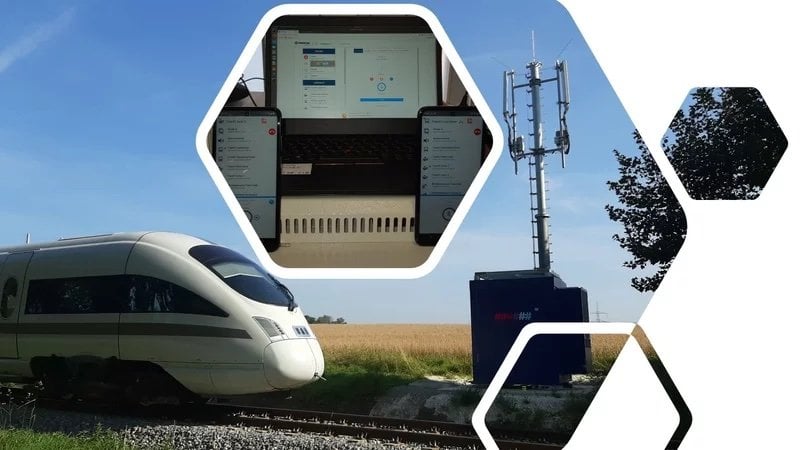railway-international.com
05
'22
Written on Modified on
First FRMCS end-to-end Transmission in Digital Rail 5G Trial Project
In the Digital Rail Testbed in Germany’s Ore Mountains, the sector initiative Digitale Schiene Deutschland, Nokia and Kontron Transportation are jointly building a 5G-based communication network to test the Future Railway Mobile Communication System (FRMCS). Now an important milestone could be reached by realizing one of the first FRMCS test calls worldwide.

For the digitalisation of the railway system envisaged by Digitale Schiene Deutschland and the technologies it introduces into the railway sector, such as artificial intelligence, state-of-the-art sensor technology and high-precision train localisation, FRMCS provides an essential foundation. This is due to digitalisation going hand in hand with new use cases and more demanding requirements for data communication. FRMCS will complement the current GSM-R radio system during a migration phase and replace it in mid-term future.
FRMCS is technically composed of the so-called "transport stratum" and the "service stratum". The transport stratum is realised via 5G and forms the transmission layer for the service stratum, which itself is implemented via the 3GPP Mission Critical Services (MCx) framework. The MCx framework provides additional functionalities, e.g. for authentication, group calls and video transmission, which are needed by today's and tomorrow’s railway applications, for instance for automated driving or future AI based traffic management.
In one of the world's first FRMCS test installations in the Digital Rail testbed in the Ore Mountains, Nokia is providing the 5G technology for the project, while Kontron Transportation is implementing the Mission Critical services (MCx). Both solutions are based on the current 3GPP Release 16 mobile communications standard. DB Netz is providing the test field, including infrastructure, as part of the Digitale Schiene Deutschland sector initiative: A total of eight radio sites along a 10 km railway track, masts and fiber optic connections, as well as a site for the server infrastructure in Scheibenberg rail station.
In the collaboration, the partners actively build up experience with FRMCS and also contribute findings and learnings back into the ongoing FRMCS standardization. Thus, the FRMCS testing in the Ore Mountains also plays a decisive role for the European and worldwide FRMCS introduction.
In the test installation, Nokia is relying on proven components for the radio interface (“5G Airscale Radio”), a compact control center for the communication network (“5G Stand-Alone Cloud Packet Core”), and components for connecting and synchronising all network components.
At the radio sites along the test track and on the roof of the Scheibenberg station, so-called "remote radio heads" and antennas with a 4x2 MIMO configuration have been installed. This enables that signals can be better focused in the desired direction and two data streams can be transmitted in parallel. The station's lab houses the central network control, components to modulate the signals towards the antennas (so-called radio Base Band Units) and a network service and test platform to support future test campaigns. All components can also be accessed remotely for operation and monitoring.
Kontron Transportation is supplying the MCx solution for this purpose. This solution is already being used by several railway companies. Among other things, it consists of a central component for implementing voice services and an additional server for realisation of further, data-based applications. The Kontron solution also includes smartphones with a specific MCx application and an application for dispatcher functions.
Installation work for the FRMCS system started at the end of 2021. Now it has been upgraded to a functional 5G stand-alone network and integrated with the MCx components. An important milestone was reached on February 23, 2022: A MCPTT ("Mission-Critical Push-to-Talk") call was realized over the newly built 5G stand-alone cellular network. This basic functionality, demonstrating successful integration of the different components, of an FRMCS system could thus be tested here for the first time in a live system. For the entire system, this means a major milestone passed: for the future 5G-based railroad radio network FRMCS itself and for the introduction of new technologies into the railway system.
Moving forward, the FRMCS test system will be expanded both spatially and technically in the coming months: Additional locations for antennas will be set up and put into operation and further equipment - especially on trains - will be integrated. The already existing equipment will also be gradually supplemented with further functionalities. Over the coming years, the test field will then be used for further FRMCS trials by the partners, e. g. for testing so-called hybrid network architectures, in which a public mobile network serves as a fallback layer or as a capacity complement to the railway’s own mobile network. Furthermore, new applications of the automated rail system based on FRMCS will be tested in the future, for instance in the context of the new sector programme "Europe's Rail". The tests will likely include the evaluation of an evolved European Train Control System (ETCS) approach (Level 3 Hybrid Moving Block) which is based on a novel safety architecture and allows trains to run at optimal distance, and hence to significantly increase the train capacity on the rails.
www.nokia.com

